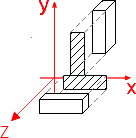
The choice between plane-parallel, axisymmetrical or 3D formulation is performed by selecting the proper model class in the Problem properties dialog.
Plane-parallel approximation means that the geometry, boundary conditions, field sources, material properties and thus the calculated field depend on X and Y coordinates, but independent of Z coordinate.

Axisymmetrical formulation means that the geometry, boundary conditions, field sources, material properties and thus the calculated field depend of Z and R, but independent from θ coordinate.

It means that all the half cross-sections, which include the rotational axis X and positioned on one side from it, are the same (i.e. independent from the angular coordinate θ).
In the screen plane we work with upper half of the axial cross section of the model
In 3D problems the model geometry, material properties, field sources and/or boundary conditions may depend upon all three spatial coordinates X, Y and Z.
3D geometry model in QuickField may be created by two methods: Z-direction extrusion from the XY plane of the 2D model, or 3D geometry import from the CAD program. The creation method is defined by the model class "3D Extrusion" or "3D import".
3D geometry of the model of the "3D Extrusion" class is built by extrusion of the flat shapes from the XY geometry into Z direction at the set height. Every planar object may be extruded several times for different heights, which allows creation of the complicated multilayered design.

Majority of the CAD programs allow saving the geometry models in the STEP format (ISO 10303). If the model class is "3D Import" then working with the geometry model in QuickField should start from the importing the previously prepared STEP file (usually with extension .step or .stp). Imported model may then be complemented by the background region - rectangular box at predefined distances from the model to the box surfaces.
Related Topic:
3D Electrostatic Formulation
3D DC conduction Formulation
3D Heat transfer Formulation
Editing Problem Properties